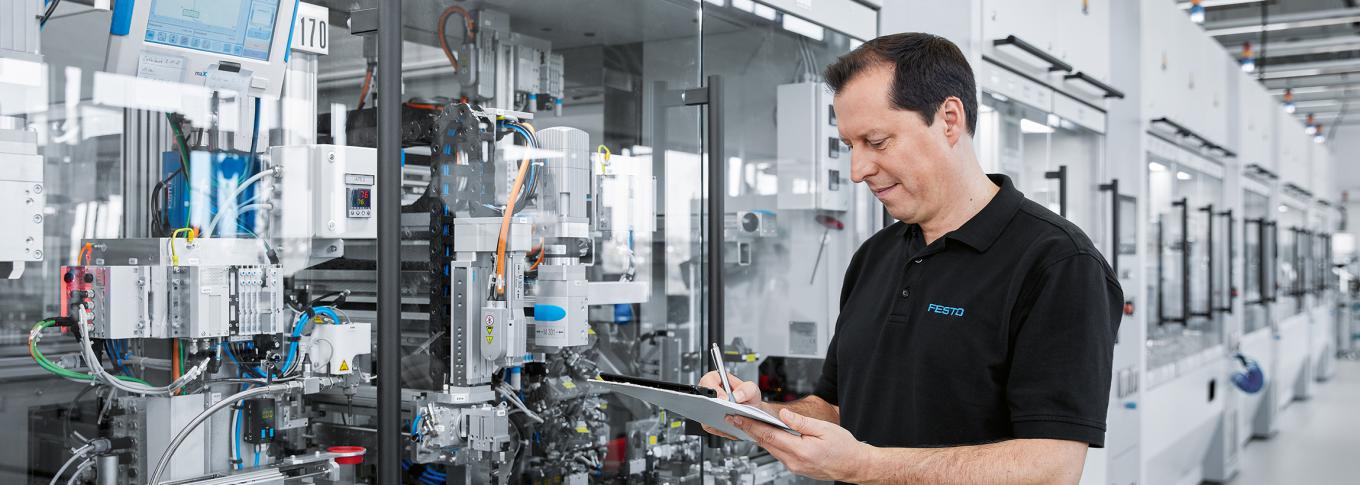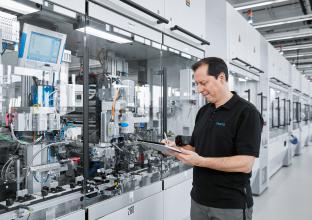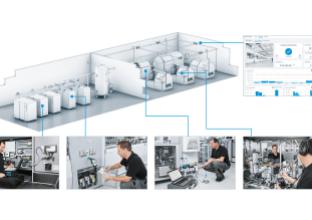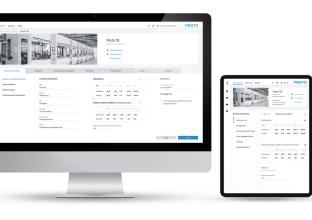
How many users of compressed air know where the weak points in their systems are?
Operating costs for pneumatic equipment can be reduced by up to 60% if system operators put into practice the results and analyses of the Compressed Air Energy Efficiency Audit GFAA by Festo. Energy efficiency experts from Festo use an integrated approach to analyse the entire compressed air system, from the compressor to the application, and recommend measures to reduce energy consumption. Climate protection is also included in the service, since the cost and energy savings naturally result in lower CO2 emissions and higher productivity.
In a study conducted by the Fraunhofer Institute for Systems and Innovation Research ISI, “Compressed Air Systems in the European Union”, the main cost drivers in compressed air systems were analysed. This found that the energy costs of compressed air generation account for the lion’s share of the overall costs at 77% – significantly more than the investment costs of 14% and the maintenance costs of 9%. It therefore seems obvious to take a closer look at these cost drivers. “The Compressed Air Energy Efficiency Audit GFAA by Festo is the right analysis tool for this,” explains Sven Lensdorf, Head of Sales Operations Services at Festo. “With the results, operators can generate compressed air more efficiently, reduce compressed air consumption and avoid pressure losses.”
Five-part audit
The audit consists of five steps. In the first three steps, the energy efficiency experts from Festo analyse the compressed air generation, compressed air preparation and compressed air distribution of the entire system. They then turn their attention to the pneumatic applications, i.e. the machines and systems themselves. They analyse the energy efficiency of these machines and systems and detect any leaks. In the fifth and final step, the specialists design a concept for a compressed air monitoring system to permanently monitor the energy states, and that can be supported by artificial intelligence at the customer’s request.
In the first step, the specialists from Festo look at the factors involved in compressed air generation. They analyse the compressor performance, the utilisation ratio, possible savings in compressed air and CO2 as well as the costs saved by switching off the compressed air supply during non-productive times. In addition, they calculate the leakage level of the production plant as well as the annual electricity and compressed air costs. A benefit is that “Festo is not a compressor manufacturer, and can therefore conduct a manufacturer-independent analysis, even while the machines are running,” adds Lensdorf. The analysis of compressed air generation brings transparency to the energy consumption as well as to the reserve capacity of the compressors.
Avoiding machine downtimes
The second step consists of analysing the compressed air preparation with its air dryers and air filters by measuring the compressed air quality. By implementing the results of the analysis, the service life of the pneumatic components can be increased and machine and production downtimes are reduced. This section of the audit ensures that the compressed air preparation system is specifically sized for optimum compressed air quality.
In the third step of the compressed air energy efficiency audit the compressed air distribution is analysed. This analysis reveals how savings in compressed air and CO2 can be made by identifying unnecessary excess pressure and reducing pressure losses and the pressure level. The energy efficiency experts from Festo measure the pressure drop and calculate the total storage capacity of the compressed air tanks and the compressed air system.
Savings potential in the machines
The fourth step of the audit focuses on the pneumatic applications in the machines and systems themselves. By measuring the pressure level and compressed air consumption directly in the machine, the specialists from Festo can advise on how to correctly size drives, valves and tubing, how blowing and vacuum applications can be optimised, how high the operating pressure should be and which are the most energy efficient installation and control concepts.
The most important efficiency measure in this context is detecting and documenting leaks, since a leaking compressed air system is a pure waste of energy and money, and compromises process reliability. According to Lensdorf: “Using highly sensitive ultrasonic detectors, the energy efficiency experts from Festo pinpoint leaks.” They detect the leaks during operation, flag them up and prioritise them based on size and costs. The analysis comprises calculations of energy costs and losses as well as CO2 emissions, a list of the spare parts required, an estimate of the time needed for maintenance, an estimate of the yearly costs and CO2 savings as well as how quickly possible measures will pay for themselves.
Online portal provides an overview
All measurement results and analysis data collected during the audit are documented on the online Energy Saving Services Portal. This online portal with mobile app makes all data globally available and accessible in real time, with user-defined access privileges. All detected leaks are identified with a QR code so they can be quickly retrieved in production. The recommended actions for optimising the compressed air energy efficiency and their savings potential are ranked in order of priority and made available on the portal; the spare parts needed to implement the optimisation measures can also be found on the portal and can be ordered directly online with one click.
If requested by the customer, the specialists from Festo can replace faulty parts such as tubing, fittings, cylinders and valves and thus create the basis for compressed air savings of up to 60%. All optimisations that are carried out and the leaks that are fixed are documented on the online portal and tracked.
The final report from the compressed air energy efficiency audit can be used for energy management in accordance with ISO 50001. The documentation also includes the CO2 emission values of the compressed air system, which machine and system operators can use for their sustainability report, for example in accordance with GRI or GHG.
Transparency with compressed air monitoring
In the fifth and final step of the audit, the energy efficiency experts from Festo design a concept for a compressed air monitoring system that will permanently monitor the status of the entire compressed air system. System operators therefore always have transparent information about flow rate, pressure and air humidity as the monitoring system checks the parameters in real time and notifies system operators if there are any irregularities – a practical tool for improving overall equipment effectiveness (OEE). Parameters that can be monitored include volumetric flow rate and consumption, pressure and pressure dew point. “Continuously recording the compressed air consumption creates energy transparency and enables maintenance measures to be scheduled at the right time,” explains Lensdorf.
Artificial intelligence
In the future, the monitoring system will also be supported by the Festo Automation Experience (Festo AX) software and will feature predictive energy management. It will use artificial intelligence to calculate how the condition of a system will change in the future. Users will thus be able to act earlier to reduce energy consumption in a targeted way.
费斯托 (Festo)是一家全球性的独立的家族企业,总部位于德国埃斯林根。自成立以来,Festo在工业自动化技术和技术教育方面制定标准,从而为环境、经济和社会的可持续发展做出贡献。公司为超过35个行业的30万家工厂和过程自动化客户提供气动和电驱动自动化技术解决方案,其中生命科学和实验室自动化业务受到越来越多的关注。Festo产品和服务遍布176个国家。2024年,费斯托在全球61个国家的250多个分支机构拥有约20600名员工,实现销售额34.5亿欧元。每年约8%的销售额用于研发。在这家学习型企业,1.5%的销售额用于基础和进一步培训。Festo 教学培训 (Didactic SE) 是全球领先的技术教育和培训供应商,为全球客户提供工业环境中全面的数字化和常规学习解决方案。



